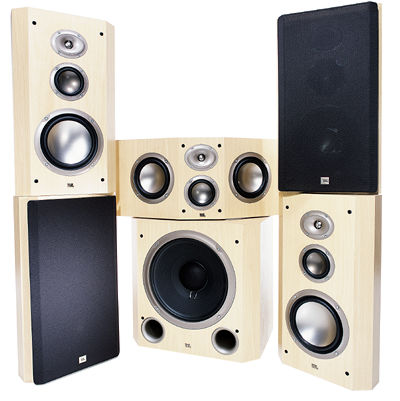JBL Performance surround speaker system

The diaphragms in JBL's Performance speakers are of pure titanium (tweeters and midranges) and titanium alloy (woofers), both combining very high rigidity with very light weight and—for metals—unusually high internal damping. They're so inert that, when you tap them, they sound more like paper or plastic than metal. The PT800BE tower's woofer "cone" just goes thunk. (Do this with the amplifier turned on, to apply its normal damping to the driver.)
I put "cone" in quotes because the Performance system's diaphragms aren't cones at all, but what JBL calls "Elliptical Oblate Spheroidal (EOS) waveguides." What the hell, you might well ask, are those? An elliptical oblate is a flattened sphere, like a beach ball with someone sitting on it, and a spheroid is a shape that's almost a sphere but isn't quite. Imagine the flattened sphere with three fourths of its height sliced off, and that's about the shape of the Performance's diaphragms.
The PT800BE satellite is a monopole that serves as the front left and right and rear surround speakers. (Some home-theater buffs prefer dipole surrounds, but I'm not one of them. I want surround effects to be capable of imaging.) Viewed from the top, the PT800BE's unusual-looking enclosure is an elongated octagon much wider than it is deep. Its relatively narrow footprint makes the PT800BE less obtrusive when it's wall- or corner-mounted (wall brackets are supplied, corner brackets are available).
The PT800BE and the PS1400BE subwoofer are cleverly designed to dock with one another, which eliminates a stability problem: the PT800BE's footprint makes it dangerously wobbly when freestanding or stand-mounted. Considering their 37-lb weight, they could do serious damage to person or property if toppled; when not docked, they should always be fastened to their bases using the threaded holes provided for docking, or be bracketed to the wall. And if stands are used, these should have wide enough bases—and/or spiked feet—to prevent the whole assembly from tipping. (If you want to be really safe, fasten the bases to the floor.)
The PT800BE isn't designed to handle deep bass, and can in fact be damaged by it, so it's essential to use it with a surround processor equipped with bass management or with the PS1400BE's internal crossover. Most audiophiles will probably opt for docking the front towers and subs, if only because that's where they've always put their woofers. But because I'm one of many who have found that the best location for a subwoofer is almost never the best location for the upper-range speakers, I opted to separate them. The sub's highpass outputs to the satellite have a fixed 130Hz crossover, and a switch on the sub selects a lowpass crossover of 130Hz (Normal) or 300Hz (Separated)—the latter clearly designed to be used in conjunction with the lowpass filter in a surround processor or receiver.
The PS1400BE has two sets of inputs: a speaker-level pair to feed a full-frequency-range signal from the main amplifier to the sub's internal crossover, and a so-called LFE, which accepts the lowpass-filtered subwoofer outputs from a receiver or surround processor. There are two bass-level controls: one affects bass level only when the amp input is used, the other controls only the subwoofer/LFE input. There's also a phase switch for use when the sub(s) and PT800BEs are widely spaced. (You set it for maximum signal output through the crossover region.)





























































